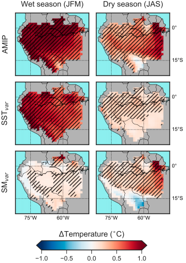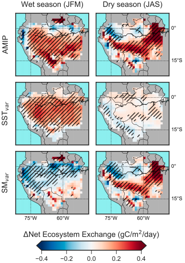The Science
During El Niño events, atmospheric teleconnections with sea surface temperature (SST) anomalies in the equatorial Pacific cause higher temperatures and reduced rainfall in the Amazon, leading to increased CO2 emissions. While some of the temperature increase results directly from the SST-atmosphere teleconnection, drier soil resulting from reduced rainfall can also contribute to higher temperatures and resulting CO2 flux anomalies. Researchers from the University of California, Irvine and the Oak Ridge National Laboratory modified the Energy Exascale Earth System Model (E3SM) to decouple the direct effects of SST anomalies from the resulting soil moisture anomalies, in order to determine the relative importance of each of these drivers.
The Impact
Soil moisture variability was found to amplify and extend the effects of SST forcing on eastern Amazon temperature and carbon fluxes in E3SM. During the wet season, the direct, circulation-driven effect of El NIño-Southern Oscillation (ENSO) SST anomalies dominated temperature and carbon cycle variability throughout the Amazon. During the following dry season, after ENSO SST anomalies had dissipated, soil moisture variability became the dominant driver in the east, explaining 67–82% of the temperature difference between El Niño and La Niña years, and 85–91% percent of the difference in carbon fluxes. These results highlight the need to consider the interdependence between temperature and hydrology when attributing the relative contribution of these factors to interannual variability of the terrestrial carbon cycle. Specifically, when offline models are forced with observations or reanalysis, the contribution of temperature may be overestimated when its own variability is modulated by hydrology via land-atmosphere coupling.
Summary
We demonstrated that in E3SM, soil moisture anomalies resulting from SST variability extended and strengthened the temperature and CO2 flux anomalies associated with ENSO. This indicates the need to consider the interdependent relationship between temperature and the hydrologic cycle when attributing mechanisms to ENSO-driven variability in the tropical terrestrial carbon cycle.


Contacts (BER PMs): Dr. Renu Joseph (Primary), SC-23, Renu.Joseph@science.doe.gov (301-903-9237); Dr. Dorothy Koch, SC-23, Dorothy.Koch@science.doe.gov (301-903-0105); Dr. Daniel Stover, SC-23, Daniel.Stover@science.doe.gov (301-903-0289)
Author Contact: Paul A. Levine, University of California, Irvine (paul.levine@uci.edu, 949-824-9030) and Dr. James T. Randerson, University of California, Irvine (jranders@uci.edu, 949-824-9030)
PI Contact: Dr. Forrest M. Hoffman, Climate Change Science Institute (CCSI), Oak Ridge National Laboratory, forrest@climatemodeling.org (865-576-7680)
Funding
This research was funded, in part, by the Reducing Uncertainties in Biogeochemical Interactions through Synthesis and Computation Scientific Focus Area (RUBISCO SFA), which is sponsored by the Regional and Global Model Assessment (RGMA) Program in the Climate and Environmental Sciences Division (CESD) of the Office of Biological and Environmental Research (BER) in the US Department of Energy (DOE) Office of Science. This research used resources from Project m2467 of the National Energy Research Scientific Computing Center, a DOE Office of Science User Facility (DE-AC02-05CH11231), and from Project cli106bgc of the Oak Ridge Leadership Computing Facility, which is a DOE Office of Science User Facility (DE-AC05-00OR22725). P.A.L. received funding support from NASA Headquarters under the NASA Earth and Space Science Fellowship Program (NNX16AO38H). J.T.R. and Y.C. received additional funding support from the DOE Office of Science Earth System Modeling Program (DE-SC0006791) and NASA’s SMAP and CMS programs. M.S.P. received funding support from the DOE Early Career Program (DE-SC0012152). M.X. and F.M.H. received additional funding support from the Energy Exascale Earth System Model (E3SM) Project and the Next Generation Ecosystem Experiments–Tropics (NGEE-Tropics) Project, sponsored by BER in the DOE Office of Science.
Publications
Levine, P. A., J. T. Randerson, Y. Chen, M. S. Pritchard, M. Xu, and F. M. Hoffman (2019), Soil moisture variability intensifies and prolongs eastern Amazon temperature and carbon cycle response to El Niño-Southern Oscillation, J. Clim., 32(4):1273–1292, doi:10.1175/JCLI-D-18-0150.1.
Related Links
Reducing Uncertainties in Biogeochemical Interactions through Synthesis and Computation (RUBISCO) Scientific Focus Area. https://www.bgc-feedbacks.org/
Energy Exascale Earth System Model (E3SM). https://e3sm.org/
Next Generation Ecosystem Experiments–Tropics (NGEE-Tropics). https://ngee-tropics.lbl.gov/